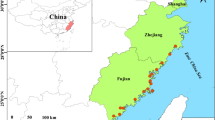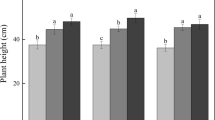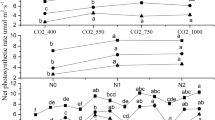Abstract
Nitrogen (N) deposition alters ecosystem structure and functioning. To study potential impacts on Mediterranean ecosystems, we designed a field fertilization experiment where NH4NO3 was added at four rates (0, 10, 20 and 50 kg N ha−1 year−1). The terricolous moss Pleurochaete squarrosa was sampled and pigments extracted in spring-autumn 2008 and spring 2009. Simulated N deposition increased lutein and VAZ pigments to chlorophyll ratios in autumn 2008; β-carotene to chlorophyll ratio was reduced in spring 2009; (neoxantin + lutein) to β-carotene increased with N supply and this was explained as higher investment in light-harvesting complexes than in reaction centres. Response of carotene to chlorophylls and of (neoxantin + lutein)/β-carotene to N enrichment were only evident when soil NH4 and Mn, respectively, were used as covariates. Thus, covariance analyses are highly recommended to detect N fertilization effects on terricolous species when field experiments are set up in highly heterogeneous environments.
Access provided by Autonomous University of Puebla. Download chapter PDF
Similar content being viewed by others
Keywords
1 Introduction
The extent to which nitrogen (N) deposition has already affected European Mediterranean ecosystems and the level of impact are un-certainties that need to be urgently addressed (Bobbink et al. 2010). Vourlitis et al. (2009) proposed using experimental evidence from Californian Mediterranean-type ecosystems to predict potential N impacts. However, the environmental problems and hysteresis of both areas are not the same. In addition, their soil fertility, which could determine potential responses to N addition, is usually different; e.g. Californian soils are richer in phosphorus (P) (Hobbs and Richardson 1995). Mediterranean mosses from herbaria collections, particularly the drought-tolerant and relatively abundant species Pleurochaete squarrosa (Brid.) Lind., have been shown to accumulate deposited N in tissues, which makes it a good potential bio-indicator (Peñuelas and Filella 2001). However, studies using mosses as indicators of N pollution are only common in temperate and boreal areas . In these areas, mosses affected by elevated N deposition have declined and shown altered pigment composition and ratios (Arróniz-Crespo et al. 2008). This decline is assumed to operate via N to P imbalance or because of direct N toxicity (Arróniz-Crespo et al. 2008), yet the importance of other nutrients, including micro-nutrients, has not been evaluated.
The first goal of this study was to determine the effects of simulated N deposition on pigment ratios (chlorophyll a/b, carotenoids to chlorophylls, and (neoxantin + lutein) to β-carotene) of the Mediterranean moss P. squarrosa. If proved to be sensitive enough, these ratios could be used to predict N deposition loads at national and international scales, given the wide distribution within the Mediterranean Basin of this moss species. A second goal was to identify which soil variables best explain pigment ratios and if they condition responses to N fertilization through N deposition. We hypothesized that, being a terricolous species in tight contact with soil surface, responses of pigment ratios will be related not only to N enrichment but also to the heterogeneous spatial and temporal distribution of certain soil nutrients. Based on previous work, we also hypothesized an increase of pigments forming part of light-harvesting complexes (involved in photo-protection mechanisms) in relation to those of reaction centres (Arróniz-Crespo et al. 2008).
2 Methods
2.1 Study Area
This study was conducted in a semi-arid Mediterranean thicket located within the Nature Reserve El Regajal-Mar de Ontígola (Central Spain, 40° 00′ N, 3° 36′ W; mean altitude ~ 500–600 m asl). Annual rainfall is ~ 425 mm, confined to the period between October and May (mainly in winter months). Annual plants are absent most of the year and a diverse and well-developed late-successional biological soil crust composed by terricolous lichens and mosses (predominantly P. squarrosa) is characteristic of the interspaces between shrubs . The relief is hilly and the thicket is located at the high and middle parts of the hills. Soils are rich in calcium carbonate and with a slightly basic pH (8.01 in spring 2009); nitrate is the dominant inorganic N form in soils (~ 2-fold greater than ammonium in spring 2009) (Ochoa-Hueso and Manrique, unpublished data); phosphate in soils is usually below 1 mg kg−1 and higher values are related to animal activity, mainly rabbits and partridges. Temporal variation (seasonality) of nutrients in soil is high, independent of simulated N deposition treatments, corresponding to this type of seasonal ecosystems (Ochoa-Hueso and Manrique, unpublished manuscript) .
2.2 Nitrogen Fertilization Experiment
24 plots (2.5 × 2.5 m) were established in October 2007 within the thicket in a 6-block design. Each plot in each block was randomly assigned to one of four N treatments (0, 10, 20 and 50 kg N ha−1 year−1) over the background deposition (~ 22 kg N ha−1 year−1; Ochoa-Hueso and Manrique 2011). All treatments, excluding the latter, are within the predicted deposition scenarios for the Mediterranean Basin by 2050 (Phoenix et al. 2006) or in the range of N deposition loads measured in other Mediterranean regions (Fenn et al. 2003). Nitrogen was applied monthly as wet deposition (2 L NH4NO3 solution, providing 0, 19, 37 and 93 mM (NO3 − + NH4 +) concentrations). During the dry period (July-August) treatments were not added and the 3-month N load was applied in September, simulating the peak of N availability with the onset of rain (Fenn et al. 2003) .
2.3 Pigment Analyses
Three fragments from different clonal individuals of P. squarrosa were taken in spring and autumn 2008 and spring 2009 from each plot. Samples from 2008 were air-dried and stored in paper bags (we did so taking into account that individuals of this species remain dry a high proportion of the year and after Esteban et al. 2009). Samples from 2009 were deep-frozen with liquid nitrogen and stored at − 20 °C. Chlorophylls (a and b), β-carotene, neoxanthin, lutein, and VAZ cycle pigments (violaxathin, anteraxanthin, and zeaxanthin) were separated by HPLC (Waters, U.S.A.) as described in Martínez-Ferri et al. (2000). Pigment reports are expressed as pigment ratios.
2.4 Soil Sampling and Chemical Analysis
Soil samples 4 cm deep were seasonally removed (from autumn 2008 to summer 2009) from each plot. Samples were then air-dried and stored at room temperature in the dark. Soil pH was measured in water; organic matter and organic N were assessed by acid digestion and oxidation; extractable P (5 g of soil in 25 ml 0.001 M CaCO3, 0.001 MgCO3, 0.04 M CH3COOH, 0.003 M H2SO4 extractant solution), extractable base cations (Ca, Na, Mg and K; 2.5 g of soil extracted in 25 ml of M CH3COONH4 at pH 7), and extractable non-base cations (Fe, Mn, Zn, Cu and Al; 2.5 g of soil extracted with 0.5 M CH3COOHNH4, 0.5 M CH3COOH and 0.02 M EDTA) were analysed by ICP-OES at the Unit of Analysis of the Centre for Environmental Sciences (CSIC, Madrid, Spain) as extensively described in Campos-Herrera et al. (2008). Soil nitrate (NO3 −) and ammonium (NH4 +) were colorimetrically evaluated after extraction in deionised water. Gravimetric soil water content was also calculated .
3 Data Analysis
Analysis of variance (ANOVA) for repeated measures (RM) was used for the effects of N supply (fixed factor) and sampling season (repeated factor). Repeated measures approximation was used because of the clonal nature of the selected moss species and given the high probability of sampling the same individual in different sampling seasons. One-way ANOVA was also used for the effects of N treatments by season. LSD tests were used for post-hoc comparisons. When tests were non-significant, we used soil variables as covariates (current season, four-season average, and seasonal values) by ANCOVA procedures. Seasonality of soil parameters was assumed to be reflected by standard deviation to a certain degree. Stepwise linear regressions were used for the effects of soil variables (current season, average and seasonal values) on pigment ratios. When necessary, data were transformed to fit tests’ assumptions. SPSS17.0 package was used and statistical significance was established at P = 0.05.
4 Results
Nitrogen effects on pigment ratios and their seasonal variation are reported in Table 23.1 and Fig. 23.1. Carotenoids to chlorophyll ratios were highly seasonal. When analysing by season, lutein to chlorophyll and VAZ to chlorophyll ratios were significantly increased by N supply in autumn 2008, and carotene to chlorophyll was marginally decreased by N in spring 2009 when current season ammonium was the covariate . Chlorophyll a/b ratios seasonally changed, but overall season-based effects of either N fertilization or the interaction between N and season were non-significant. (Neoxantin + lutein) to β-carotene ratio was seasonal and there was a significant effect of N when Mn seasonality was used as covariate; the interaction N x season was not significant for this ratio. Sorted by season, this ratio was not affected by N in spring 2008, affected in autumn 2008 when current season Mn was used as covariate, and affected in spring 2009. Results from the stepwise linear regression analyses are shown in Table 23.2.
Nitrogen fertilization effects on carotenoid to chlorophyll ratios in a spring 2008, b autumn 2008, and c spring 2009. Same letter above SE bars indicates no significant differences (P > 0.05) between treatments. Neo (neoxanthin), lut (lutein), chlo (chlorophyll a + b), carot (β-carotene), VAZ (VAZ cycle pigments). Open (0N), light-grey (10N), dark-grey (20N), dark (50N)
Nitrogen fertilization effects on chlorophyll a/b and (neoxantin + lutein)/β-carotene ratios in a spring 2008, b autumn 2008, and c spring 2009. Same letter above SE bars indicates no significant differences (P > 0.05) between treatments. Neo (neoxanthin), lut (lutein), chlo (chlorophyll a + b), carot (β-carotene), VAZ (VAZ cycle pigments). Open (0N), light-grey (10N), dark-grey (20N), dark (50N)
5 Discussion
Photosynthetic pigments and pigment ratios provide good complementary indicators of N pollution effects and of physiological recovery (Arróniz-Crespo et al. 2008). In temperate areas, decreased chlorophyll a/b and increased (neoxanthin + lutein) to β-carotene ratios after N fertilization have been related to higher proportions of light-harvesting complexes compared with reaction centres. We have proved the latter to be also true in Mediterranean ecosystems subjected to N enrichment.
Increased pigment concentrations (usually chlorophylls) are a typical consequence of N deposition in mosses and lichens (Sánchez-Hoyos and Manrique 1995; Arróniz-Crespo et al. 2008; Ochoa-Hueso and Manrique, unpublished manuscripts) but a reduction has also been reported in lichens fumigated with nitric acid (Riddell et al. 2008) . Thus, pigment responses to N enrichment may depend on the dominant N form (wet vs. dry and oxidized vs. reduced), pollution load and also on the plant species (Sánchez-Hoyos and Manrique 1995; Arróniz-Crespo et al. 2008; Riddell et al. 2008). In contrast, other pigments such as β-carotene can remain un-alterered, or just show small responses (increasing or decreasing) at different rates (Ochoa-Hueso and Manrique, unpublished manuscript). Thus, the alteration of pigment ratios will be related to impaired responses of different pigments, which should reflect physiological priorities either for photosynthesis or protection against photo-oxidation.
Additionally, terricolous moss species, in close contact with the soil surface, are usually micronutrient-limited (Bowker et al. 2005; Ochoa-Hueso and Manrique, unpublished manuscript); particularly, this study suggests that soil NH4 + and Mn2+ influence responses of P. squarrosa to N enrichment. The positive (and masking) relationship between β-carotene to chlorophylls with soil NH4 + (data not shown) could be reflecting the need for protection against excessive photo-oxidation if high soil NH4 + levels are damaging cellular machinery. The increase of carotene in relation to (neoxanthin + lutein) when Mn2+ increases is, in turn, most likely linked to the importance of Mn2+ for carotene formation (Blaya and García 2003).
6 Concluding Remarks
Responses of terricolous mosses to N enrichment may be mediated by existing soil environmental conditions and micronutrient demand and thus direct statistical comparisons with samples taken from low-replicated field experiments in highly heterogeneous environments may not be powerful enough to detect significant effects of treatments; therefore, covariance analysis are highly recommended in such cases. Finally, (neoxanthin + lutein)/β-carotene seems to consistently respond to N enrichment across biomes (temperate and Mediterranean), suggesting its potential use as a bio-indicator.
References
Arróniz-Crespo, M., Leake, J. R., Horton, P., & Phoenix, G. K. (2008). Bryophyte physiological responses to, and recovery from, long-term nitrogen deposition and phosphorous fertilisation in acidic grassland. New Phytologist, 180, 864–874.
Blaya, S. M., & García, G. N. (2003). Química agrícola, 2nd edn. Madrid: Ediciones Mundi-Prensa.
Bowker, M. A., Belnap, J., Davidson, D. W., & Phillips, S. L. (2005). Evidence for micronutrient limitation of biological soil crusts: Importance to arid-lands restoration. Ecological Applications, 15, 1941–1951.
Bobbink, R., Hicks, K., Galloway, J., Spranger, T., Alkemade, R., Ashmore, M., Bustamante, M., Cinderby, S., Davidson, E., Dentener, F., Emmet, B., Erisman, J.-W., Fenn, M., Gilliam, F., Nordin, A., Pardo, L., & De Vries, W. (2010). Global assessment of nitrogen deposition effects on terrestrial plant diversity: A synthesis. Ecological Applications, 20, 30–59.
Campos-Herrera, R., Gómez-Ros, J. M., Escuer, M., Cuadra, L., Barrios, L., & Gutierrez, C. (2008). Diversity, occurrence, and life characteristics of natural entomopathogenic nematode populations from La Rioja (Northern Spain) under different agricultural management and their relationships with soil factors. Soil Biology & Biochemistry, 40, 1474–1484.
Esteban, R., Balaguer, L., Manrique, E., Rubio de Casas, R., Ochoa, R., Fleck, I., Pintó-Marijuan, M., Casals, I., Morales, D., Jiménez, M. S., Lorenzo, R., Artetxe, U., Becerril, J. M., & García-Plazaola, J. I. (2009). Alternative methods for sampling and preservation of photosynthetic pigments and tocopherols in plant material from remote locations. Photosynthesis Research, 101(1), 77–88.
Fenn, M. E., Baron, J. S., Allen, E. B., Rueth, H. M., Nydick, K. R., Geiser, L., Bowman, W. D., Sickman, J. O., Meixner, T., Johnson, D. W., & Neitlich, P. (2003). Ecological effects of nitrogen deposition in the Western United States. Bioscience, 53, 404–420.
Hobbs, R. J., & Richardson, D. M. (1995). Mediterranean-type ecosystems: Opportunities and constraints for studying the function of biodiversity. In G. W. Davis & D. Richardson (eds.), Mediterranean-type ecosystems. The function of biodiversity (pp. 1–42). Berlin: Springer-Verlag.
Martínez-Ferri, E., Balaguer, L., Valladares, F., Chico, J. M., & Manrique, E. (2000). Energy dissipation in drought-avoiding and drought-tolerant tree species at midday during the Mediterranean summer. Tree Physiology, 20, 131–138.
Ochoa-Hueso, R., & Manrique, E. (2011). Effects of nitrogen deposition and soil fertility on cover and physiology of Cladonia foliacea (Huds) Willd., a lichen of biological soil crusts from Mediterranean Spain. Environmental Pollution, 159, 449–457.
Peñuelas, J., & Filella, I. (2001). Herbaria century record of increasing eutrophication in Spanish terrestrial ecosystems. Global Change Biology, 7, 427–433.
Phoenix, G. K., Hicks, W. K., Cinderby, S., Kuylenstierna, J. C. I., Stock, W. D., Dentener, F. J., Giller, K. E., Austin, A. T., Lefroy, R. D. B., Gimeno, B. S., Ashmore, M. S., & Ineson, P. (2006). Atmospheric nitrogen deposition in world biodiversity hotspots: The need for a greater global perspective in assessing N deposition impacts. Global Change Biology, 12, 470–476.
Riddell, J., Nash, T. H. III, & Padgett, P. (2008). The effect of HNO3 gas on the lichen Ramalina menziesii. Flora, 203, 47–54.
Sánchez-Hoyos, M. A., & Manrique, E. (1995). Effect of nitrate and ammonium ions on the pigment content (xanthophylls, carotenes and chlorophylls) of Ramalina capitata. Lichenologist, 27, 155–160.
Vourlitis, G. L., Pasquini, S. C., & Mustard, R. (2009). Effects of dry-season N input on the productivity and N storage of Mediterranean-type shrublands. Ecosystems, 12, 473–488.
Acknowledgments
This research was financially supported by an FPU grant of the Spanish Ministerio de Educación y Ciencia to ROH (AP2006–04638) and by projects (CGL-2009–11015, AGL-2006–13848-C02–01/AGR, S2009/AMB-1783 and S-0505/AMB/0032 projects). We are thankful to Dr. Lucy J. Sheppard for instructive comments on an early version of the manuscript.
Author information
Authors and Affiliations
Corresponding author
Editor information
Editors and Affiliations
Rights and permissions
Copyright information
© 2014 Springer Science+Business Media Dordrecht
About this chapter
Cite this chapter
Ochoa-Hueso, R., Paradela, C., Pérez-Corona, M., Manrique, E. (2014). Pigment Ratios of the Mediterranean Bryophyte Pleurochaete squarrosa Respond to Simulated Nitrogen Deposition. In: Sutton, M., Mason, K., Sheppard, L., Sverdrup, H., Haeuber, R., Hicks, W. (eds) Nitrogen Deposition, Critical Loads and Biodiversity. Springer, Dordrecht. https://doi.org/10.1007/978-94-007-7939-6_23
Download citation
DOI: https://doi.org/10.1007/978-94-007-7939-6_23
Published:
Publisher Name: Springer, Dordrecht
Print ISBN: 978-94-007-7938-9
Online ISBN: 978-94-007-7939-6
eBook Packages: Earth and Environmental ScienceEarth and Environmental Science (R0)






